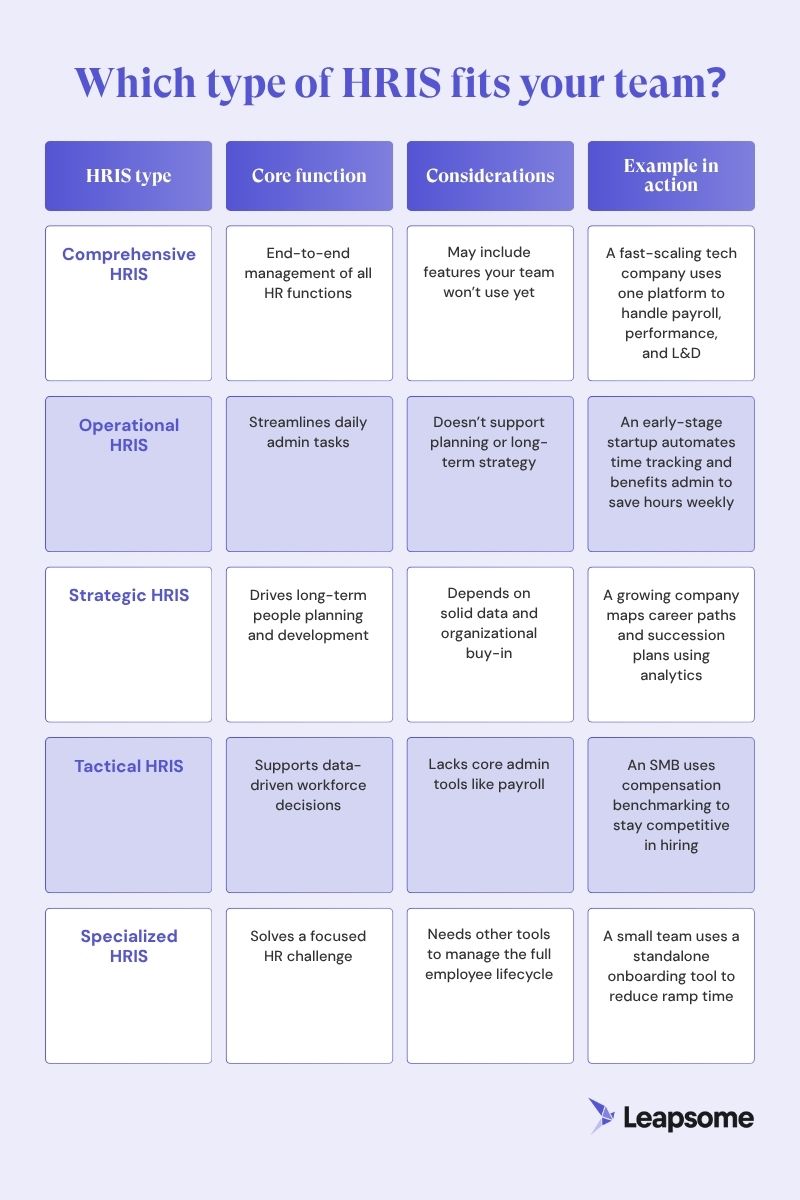The 5 types of HRIS platforms: a guide

Over the past year, HR leaders have faced rising pressure to prove ROI, consolidate workflows, and drive strategic decisions — all while keeping teams engaged and aligned. However, 92% say internal barriers stall people-first initiatives.
This disconnect makes it difficult to link employee engagement efforts to measurable business impact — and even harder for executives to recognize their value. A key underlying issue: fragmented systems that make it hard to streamline HR processes or extract meaningful insights from employee data.
The obvious response for many HR teams is to turn to an HRIS platform that automates manual tasks, reduces silos, and improves visibility across all your HR operations. But with multiple types of HRIS available, it’s not always clear which solution best supports your needs now — or which can scale with your team over time.
Use this guide to clarify the types of HRIS solutions available and help define which kind best fits your organization — both today and as your operations evolve.
📈 Connect every stage of the employee lifecycle with Leapsome’s people-first HRIS
Run automated HR processes, make data-driven people decisions, and put an end to admin fatigue.
👉 Learn more
*Leapsome’s HR Insights Report, 2025
What are the different types of HRIS platforms?
HRIS platforms can serve different functions depending on how broad or specialized their features are. Most fall into one of five categories:
- Comprehensive HRIS — All-in-one systems covering core HR, payroll, benefits, performance, and sometimes strategic HR management.
- Operational HRIS — Focuses on day-to-day HR tasks like time tracking, employee records, and benefits administration.
- Tactical HRIS — Supports mid-level planning, like workforce scheduling, compensation modeling, or recruitment workflows.
- Strategic HRIS — Used for long-term planning and alignment with business goals. Often includes succession planning and predictive analytics.
- Specialized or limited-function HRIS — Targets a specific HR need, for example, payroll or onboarding, and is often used by small businesses alongside other HR tools.
We look at each of these types of HRIS below, including when to use them and what limitations to expect.
What’s the difference between an HCM, an HRIS & an HRMS?
The difference between an HRIS, an HRMS, and an HCM mostly comes down to scope. Each term refers to a different level of functionality and strategic focus in HR software:
- HRIS platforms — Cover core HR functions like payroll, benefits administration, time tracking, and employee records management.
- Human resources management systems (HRMS) — Build on HRIS functionality by including broader workforce management features such as recruiting, onboarding, performance tracking, and learning management.
- Human capital management software (HCM) — Includes HRIS and HRMS features but goes further, offering tools for strategic workforce planning, succession management, and business system integration. It’s often adopted by enterprise organizations aiming to align HR with broader business objectives.
The 5 main types of HRIS platforms & their best use cases
HRIS platforms come in different forms depending on what they’re built to support. Some focus on daily admin, while others help guide long-term people strategy. Below, we break down the five main types of HRIS platforms — what they do, where they’re strong, what they leave out, and which use cases they’re best suited for.

HRIS type #1: comprehensive HRIS

A comprehensive HRIS is an integrated platform that centralizes all HR-related data and functions within a single ecosystem. Unlike other systems that focus on specific aspects of HR management, a comprehensive HRIS unifies operational, tactical, and strategic HR functions into one unified solution.
Comprehensive HRIS platforms typically include features for:
- Absence management and time tracking
- Compensation and benefits administration
- Employee data management
- Learning and development
- Payroll
- Performance management
- HR reporting and HR analytics
Leading comprehensive HRIS solutions go beyond these basics. For example, Leapsome brings together core HR capabilities and employee engagement features to give you a single solution for all your People management processes. This includes People analytics, industry-leading AI features, and powerful automation capabilities.
🤔 Did you know? Employees who use a single HR platform are 21% more likely to feel confident about finding critical HR info than those juggling multiple tools.
Limitations
Comprehensive HRIS platforms can be more complex to implement and configure, especially if you're migrating from fragmented tools or spreadsheets. Teams with very specific or industry-unique workflows may still need point solutions or custom integrations alongside a full-suite HRIS.
Best use case
Comprehensive HRIS platforms can accommodate most HR tasks and are ideal for teams of all sizes seeking a full-service HR software solution. For example, Leapsome is a strong fit for professional service providers, SMBs, fast-scaling tech companies, and complex enterprises.
That said, comprehensive HRIS platforms can also play a vital role for small to medium-sized businesses and startups that need a wide range of features without large, specialized HR teams.
✅ Check all the boxes with a comprehensive HRIS
Leapsome’s HRIS is a holistic, people-first solution serving as a single source of truth for all your HR needs.
👉 Learn more
HRIS type #2: operational HRIS
An operational HRIS focuses on daily tasks that keep your organization running smoothly. These systems are designed to improve existing workflows by making them more efficient and impactful, particularly for basic HR administration tasks and talent management.
Some operational HRIS platforms offer applicant tracking systems (ATS), which help HR teams recruit and hire by automating job posting and candidate screening. Operational HRIS options may include performance management, payroll and benefits administration functions, and employee records management.
Limitations
Operational HRIS platforms don’t offer much functionality related to HR analytics, people enablement, and goal-setting, so you’d likely need to adopt additional HR software to compensate in those areas.
Best use case
An operational HRIS is a good option for organizations looking to simplify core HR functions without advanced features or data analytics.
If your HR team spends too much time on repetitive tasks or rifling through spreadsheets for employee data, an operational HRIS could expedite their ways of working and increase efficiency. It’s a practical and budget-friendly option for businesses that want to improve their core HR processes.
HRIS type #3: strategic HRIS
Strategic HRIS platforms help organizations make informed, data-guided decisions about workforce planning, professional growth and development, and other people-centered initiatives that fall under the umbrella of human capital management. As the name implies, a strategic HRIS focuses on high-level analysis, planning, and goal-setting tasks.
Think of a strategic HRIS platform as the complement (or opposite) of an operational HRIS solution. The latter focuses on daily, here-and-now HR needs, while the former helps with forward-looking tasks related to people enablement.
For example, some strategic HRIS platforms include a learning management system (LMS). These solutions give HR teams access to ready-to-use learning materials, enable them to build custom courses, and help them track employee development and training. This shows the organization’s investment in team members’ growth and ensures they progress on their desired career path.

Our HRIS tool is comprehensive, but our software solution also comes with a Learning module that’s designed to help companies upskill and empower their people. It gives users access to a learning marketplace filled with top-quality training courses for everything from compliance to soft skills. It also enables People teams to create their own development materials with the power of AI.
Limitations
Strategic HRIS features typically require a foundation of accurate, well-maintained employee data from other HR systems. If your organization lacks that foundation or isn’t ready to act on high-level insights, these tools may go underused. Also, companies focused solely on administrative HR functions may not benefit from the added complexity of a strategy-focused HRIS solution.
Best use case
A strategic HRIS is best for large, well-established organizations or smaller companies that are scaling quickly and considering sustainable growth. Strategic HRIS platforms focus on longer-term initiatives like career pathing, succession planning, and team development.
These solutions are particularly beneficial if you’ve identified data-driven decision-making as an area of opportunity in your HR function.
HRIS type #4: tactical HRIS
Tactical HRIS platforms support mid-range planning and decision-making, sitting between day-to-day operations and long-term strategic goals. While a strategic HRIS focuses on high-level initiatives like workforce and succession planning, a tactical HRIS helps bridge strategy and operations.
Therefore, by combining internal and external data (like industry compensation benchmarks), tactical HRIS systems typically help with the following:
- Recruitment and applicant tracking
- Onboarding, compensation, and benefits
- Performance management
- Compensation and benefits analysis
- Compliance and external data management

Benchmarking is another important tactical HRIS platform capability. By understanding how competitors compensate their team members or recruit new hires, tactical HRIS solutions can help uplevel your internal processes to ensure you’re attracting top talent and building high-performing teams over time.
Although Leapsome’s HRIS is comprehensive, our platform also has a compensation benchmarking feature. It’s powered by industry leader Mercer and provides real-time data about salary and benefits benchmarks, helping HR leaders make informed decisions about compensating their people above and beyond the industry standard. This data is critical to making good decisions for your people and business.
Limitations
Tactical HRIS platforms typically don’t include core operational tools like payroll, benefits admin, or time tracking. Without broader functionality, you may still need additional systems to cover foundational HR processes.
Best use case
A tactical HRIS is best suited for organizations looking to maximize efficiency and make data-based decisions about workforce management. If big-picture decisions about growth are a recurring issue for your team, a tactical HRIS may be a good fit.
HRIS type #5: specialized or limited-function HRIS
A specialized or limited-function HRIS focuses on one or two core HR tools, like payroll or time off management. Consider this a starter solution if you’re not ready for a complete ecosystem.
Limitations
Specialized HRIS platforms are highly focused in their functionality and so do not offer the integrated benefits of an all-in-one solution.
Best use case
These platforms are budget-friendly for small businesses that need only a narrow set of HR features.
How to select the best type of HRIS for your needs

The right type of HRIS for your organization depends on your company’s stage of growth, the complexity of your HR operations, and the systems you already have in place.
Early-stage companies or those with lean People teams might prioritize operational tools to streamline repetitive tasks like data entry, time tracking, or compliance. In some cases, a small business may face bottlenecks or burnout in a specific area of HR. A specialized HRIS can target that pain point and significantly reduce the administrative load.
In practice, though, many companies outgrow their initial systems and, as teams mature, the need often shifts toward more tactical and strategic capabilities — like compensation planning, learning paths, or People analytics.
As a result, starting with a basic or operational HRIS can work short-term, but if your team’s responsibilities are expanding, you’ll need a platform that scales with your business. That’s where a comprehensive solution, like Leapsome’s HRIS, becomes valuable. It allows you to manage the full employee lifecycle while layering in strategic, data-based initiatives as your organization evolves.
With these considerations in mind, use the questions below to develop criteria for your buying decision — so your HRIS is fully aligned with your organization’s operations, priorities, and growth plans.
Questions to ask when choosing the best type of HRIS for your organization
Choosing the right HRIS is simpler if you know your main challenges and business objectives. Consider these questions:
- What are your primary HR challenges? Are you struggling with day-to-day administrative tasks, like payroll and employee data management, or do you need help with bigger-picture initiatives like strategic planning, talent development, and long-term objectives?
- What’s the size of your organization? Do you need a simple, operational system for basic HR tasks, or are you a larger organization that requires more comprehensive features across all HR functions (operational, tactical, strategic, or all of the above)?
- What’s your budget? Can you afford a comprehensive, all-in-one HRIS, or do you need to start with a more basic solution?
- Are you interested in automating operational tasks? Do you spend too much time on routine work like payroll, time tracking, or benefits management that could be streamlined and automated?
- What’s your plan for growth and expansion? Are you planning to scale the business, enter new markets, or make strategic hires soon?
Discover the value of an HRIS that fits your organization

Whether you want to streamline operations, nurture talent, or plan for the future, the right HRIS can help you make better, data-guided decisions. The key is choosing a solution that can adapt to your growing business while still addressing your team’s current needs.
Consider trialing a platform with strong HR and employee enablement capabilities, along with built-in modules for key processes, like time tracking, payroll, and learning. This will help you identify which HRIS features are critical requirements for today and which ones you may scale into over time.
For personalized guidance, reach out to Leapsome’s team. Our HRIS is designed to centralize core HR tasks while supporting your long-term People strategy — and we’ll work with you to determine whether it’s the right fit for your organization.
🤸 Take the leap with our comprehensive HRIS
Leapsome’s HRIS brings your core HR tasks, People data, and strategic initiatives into one powerful platform.
👉 Book a demo
Frequently asked questions about types of HRIS
What is an HRIS platform?
An HRIS platform is software designed to centralize key HR functions. While capabilities vary by platform, an HRIS can typically streamline and automate essential tasks like employee data management and time tracking. Some platforms, like Leapsome, also extend into more advanced areas like payroll and employee enablement — with solutions for performance management, surveys, learning and development (L&D), and more.
What’s a cloud-based HRIS?
A cloud-based HRIS is hosted online, allowing teams to access HR tools and employee data from anywhere. Unlike on-premise HRIS systems, it requires no local installation or maintenance and is typically updated automatically by the vendor. This setup offers greater scalability, real-time data access, and lower upfront costs. Most modern HRIS platforms, including Leapsome, are cloud-based to support remote teams and dynamic business needs.
What’s an open-source HRIS?
An open-source HRIS is software with publicly available source code that your team can modify and customize. This flexibility can be useful for companies with niche HR workflows and sophisticated in-house technical resources. However, open-source systems often require more setup, maintenance, and security oversight compared to commercial platforms. They typically lack the plug-and-play convenience, integrations, and support that come with cloud-based solutions like Leapsome.
Disclaimer: This article is for informational purposes only and doesn’t offer legal, tax, or financial advice. While we’ve done our best to ensure accuracy and completeness, we can’t guarantee everything is up-to-date or error-free. For tailored advice, we recommend consulting a qualified lawyer or tax advisor.
Ready to transform
your People operations?
Automate, connect, and simplify all HR processes across the employee lifecycle.
.webp)
.webp)
 Request a demo today
Request a demo today






.jpg)

.jpg)




















